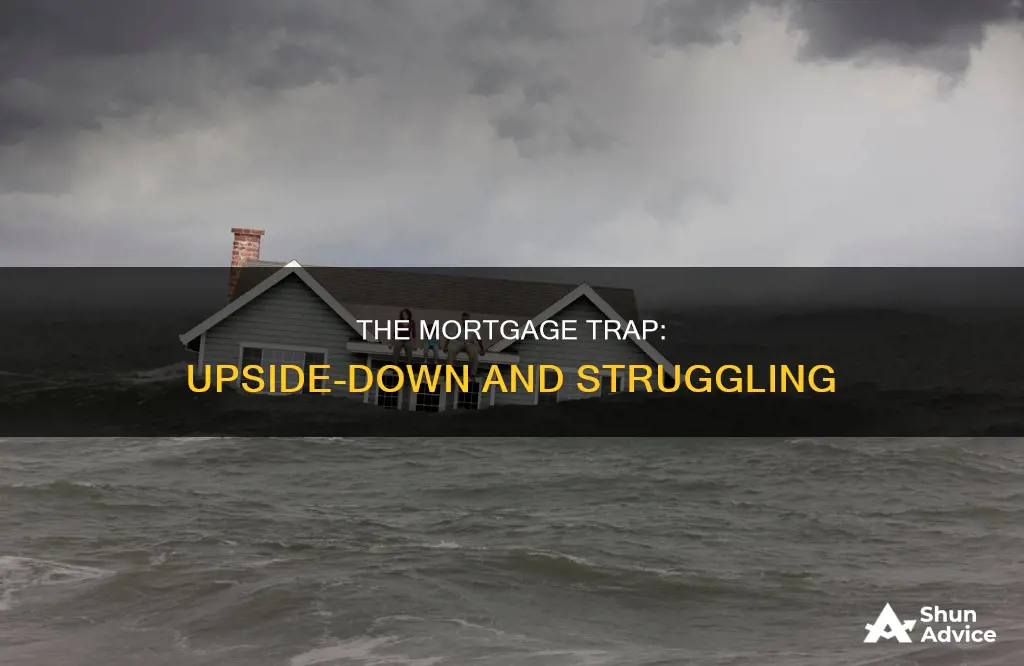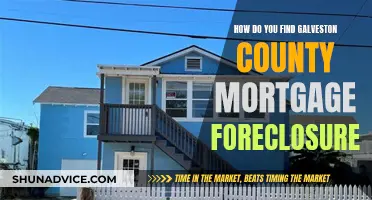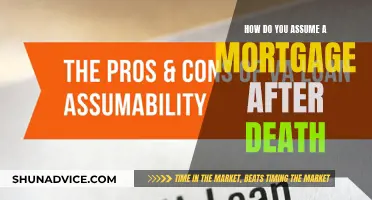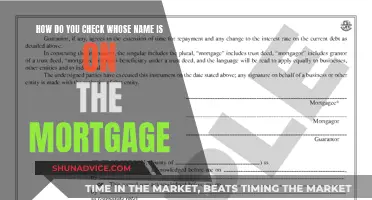
An upside-down or underwater mortgage is when the remaining principal balance exceeds the property's fair market value. This can happen due to a decrease in property value, failure to make payments, or a stagnant home price. In this situation, homeowners have a few options: they can stay in the home and continue to make payments, explore loan modifications, or consider a short sale. It is important to carefully consider the potential financial and emotional implications of each option and, if necessary, consult with a mortgage attorney to discuss legal options and protect one's financial future.
Characteristics of an Upside-Down Mortgage
| Characteristics | Values |
|---|---|
| Definition | When the remaining principal balance exceeds the property's fair market value |
| Causes | Decline in home prices, buying a home with little or no money down, taking out a second mortgage, borrowing more than 100% of the home's value, negative amortization, short-term fluctuations in the housing market, local factors such as increased crime rates or demographic shifts, failure to make payments, high-interest rates, refinancing decisions, sudden demand and market forces |
| Consequences | Higher risk of foreclosure, limited refinancing options, difficulty in selling the house, higher monthly payments, lower home equity, financial strain, stress, inability to relocate |
| Options | Stay in the home and continue making payments, explore loan modifications or refinancing options, consult a mortgage attorney, negotiate a short sale, rent out the property, file for bankruptcy, deed-in-lieu of foreclosure |
What You'll Learn

The impact of market fluctuations
Market fluctuations can cause the value of a home to depreciate, resulting in an upside-down mortgage. This can be a challenging situation for homeowners, especially if they want to sell or refinance. During periods of market volatility, it is generally advisable to avoid drastic actions, such as selling your home at a loss. Instead, it is recommended to continue making monthly mortgage payments and let the market correct itself over time.
Market fluctuations can also influence the broader housing market. An increase in upside-down mortgages can lead to a decrease in the number of homes for sale as homeowners with negative equity become reluctant to sell at a loss. At the same time, a high level of upside-down mortgages could result in an increase in foreclosures, potentially adding distressed properties to the market. Prospective homebuyers may be hesitant to enter a volatile market, and homeowners with negative equity may need to lower their asking prices to attract buyers.
To summarise, market fluctuations can lead to upside-down mortgages, impacting both individual homeowners and the broader housing market. Homeowners may face challenges in selling or refinancing their properties, and the supply of homes for sale may be affected, potentially leading to increased foreclosures and distressed sales. However, it is important to remember that market fluctuations are often temporary, and continuing to make mortgage payments can help correct the negative equity situation over time.
Becoming a Mortgage Field Inspector: A Step-by-Step Guide
You may want to see also

How to identify an upside-down mortgage
An upside-down or underwater mortgage is when the remaining principal balance exceeds the property's fair market value. This often happens when property values decline after someone purchases a home, causing the mortgage balance to exceed the home's worth. However, it can also occur when a homeowner fails to make payments, and the interest and other rates that accrue make it challenging to get back on track.
To identify if you have an upside-down mortgage, you need to determine your home's current value and then subtract how much you still owe on your mortgage from that amount. For example, if your home is currently worth $310,000, but you still owe $360,000 on your mortgage, you have an upside-down mortgage.
There are several ways to reduce the risk of ending up with an upside-down mortgage. Potential homeowners should research the area and housing market trends before purchasing a property. Current homeowners can monitor property values to determine the optimal time to sell. It is also essential to find the right loan that suits your unique financial situation.
If you find yourself with an upside-down mortgage, there are several options to consider:
- Continue making your monthly mortgage payments: If you can afford to stay in your home and keep up with the payments, this is often the best method to reverse an upside-down mortgage. Over time, your home's value may increase, and you will also begin to pay off the principal balance, bringing your mortgage right-side up.
- Explore refinancing options: Discuss refinancing options with your lender or explore government-sponsored loan programs designed to assist homeowners with upside-down mortgages, such as the Home Affordable Refinance Program (HARP) or Freddie Mac's Enhanced Relief Refinance program.
- Modify your loan: Contact your lender to discuss loan modification options. They may be willing to work with you to reduce the principal balance to match the market value of your home.
- Short-sell your home: If you need to sell your home, you may be able to do so for the market value, even if it means taking a loss.
Real Estate Strategies: Adjusting for Mortgage Rates
You may want to see also

Strategies to address the situation
If you are facing an upside-down or underwater mortgage, there are several strategies you can consider to address the situation:
Continue Making Payments
If you can afford to stay in your home and continue making mortgage payments, this is often the least problematic and best method to reverse an upside-down mortgage. With every monthly payment, you are paying off the interest on your loan and gradually reducing the principal balance, which will eventually bring your mortgage right-side up. Additionally, most housing markets tend to appreciate over time, so there is a good chance that your home's value will rise.
Principal Reduction Program
Another option is to explore a principal reduction program with your bank. This involves the bank forgiving a portion of the mortgage debt that is not covered by the current value of your home. However, this option may be challenging as it requires the bank to take a financial hit.
Refinancing Options
Fannie Mae and Freddie Mac offer refinancing programs specifically designed for homeowners with upside-down mortgages. These programs can help lower your monthly payments and interest rates, making it more manageable to stay in your home. However, refinancing may not reduce your principal balance, and you will typically need a government-sponsored loan to qualify.
Short Sale
If you need to sell your home and are unable to cover the outstanding principal balance, you may consider a short sale. In this scenario, you sell your home for less than you owe on the mortgage, and the lender receives all the proceeds from the sale. The lender may then forgive the remaining balance or seek a deficiency judgment, requiring you to pay the remaining amount.
Deed-in-Lieu of Foreclosure
In some cases, banks may offer a "deed-in-lieu of foreclosure," where you voluntarily transfer ownership of the property to the bank without going through the foreclosure process. However, this option can negatively impact your credit, and you may not walk away with any more financial benefit than if you had defaulted.
Remember that each situation is unique, and it is always best to consult with a financial professional to explore the options available to you and make an informed decision.
Strategies for Saving Your Mortgage Down Payment
You may want to see also

The role of refinancing and lenders
An upside-down mortgage, also known as an underwater mortgage, occurs when a homeowner owes more on their mortgage than the current market value of their home. This situation can be caused by a variety of factors, including declining home values, accruing interest and fees due to missed payments, or taking out a second mortgage.
Refinancing is a common strategy for homeowners with upside-down mortgages. However, refinancing options are limited when a loan is underwater, and it may be challenging to qualify for refinancing unless the borrower qualifies for a government program or certain types of mortgages. Fannie Mae offers a High Loan-to-Value (LTV) Refinance option, but it is only available for Fannie Mae mortgages with a note date of October 1, 2017, or later. Similarly, Freddie Mac offers the Enhanced Relief Refinance program with a maximum loan-to-value ratio of 105%, but borrowers must be current on their mortgage payments. These programs are designed to help borrowers with high-interest loans avoid foreclosure by reducing their interest rates and making payments more manageable.
Lenders play a crucial role in the context of upside-down mortgages. When homeowners face financial difficulties and struggle to make payments, lenders may work with them to explore alternative payment options or loan modifications. Lenders are typically motivated to avoid foreclosure because it often results in financial losses for them. Instead, they may agree to a short sale, where they accept the sale proceeds as full settlement, even if it is less than the amount owed. Additionally, lenders may offer a "deed-in-lieu of foreclosure," where the homeowner voluntarily transfers the property to the lender without going through the foreclosure process. However, it is important to note that lenders are not obligated to agree to a short sale, and their decision depends on the homeowner's financial situation and market conditions.
Navy Federal Mortgages: Competitive Rates, What Else?
You may want to see also

The emotional and financial implications
Being upside down on your mortgage can have serious emotional and financial implications. The emotional strain can be intense, with individuals often feeling trapped and stuck, with no good options available to them. This can lead to stress and a sense of hopelessness, especially if there is a desire or need to relocate for work or other opportunities. The lack of flexibility can significantly impact both personal and professional lives, potentially leading to missed advancements and decreased earning potential.
The financial implications can be equally severe. Homeowners with an upside-down mortgage may have to sell their homes for the current market value, which is often less than the mortgage amount, resulting in a loss. This can lead to a cycle of debt, with individuals struggling to catch up on payments and accruing more interest. The inability to refinance or take advantage of savings opportunities can further compound the financial strain.
The stress and worry associated with an upside-down mortgage can also affect an individual's ability to make rational decisions. In some cases, homeowners may choose to stop making mortgage payments altogether, leading to potential foreclosure. The threat of losing one's home can be emotionally devastating and financially ruinous.
However, it's important to note that there are options available to those facing an upside-down mortgage. Homeowners can choose to stay in their homes, continue making payments, and build equity over time. Improvements to the home can also increase its value. Additionally, lenders may be willing to work with homeowners, offering loan modifications, refinancing options, or principal reduction programs.
While the emotional and financial implications of an upside-down mortgage can be significant, proactive measures and a good understanding of the market and one's options can help mitigate the potential negative consequences.
Understanding Mortgage Calculations in Connecticut
You may want to see also







